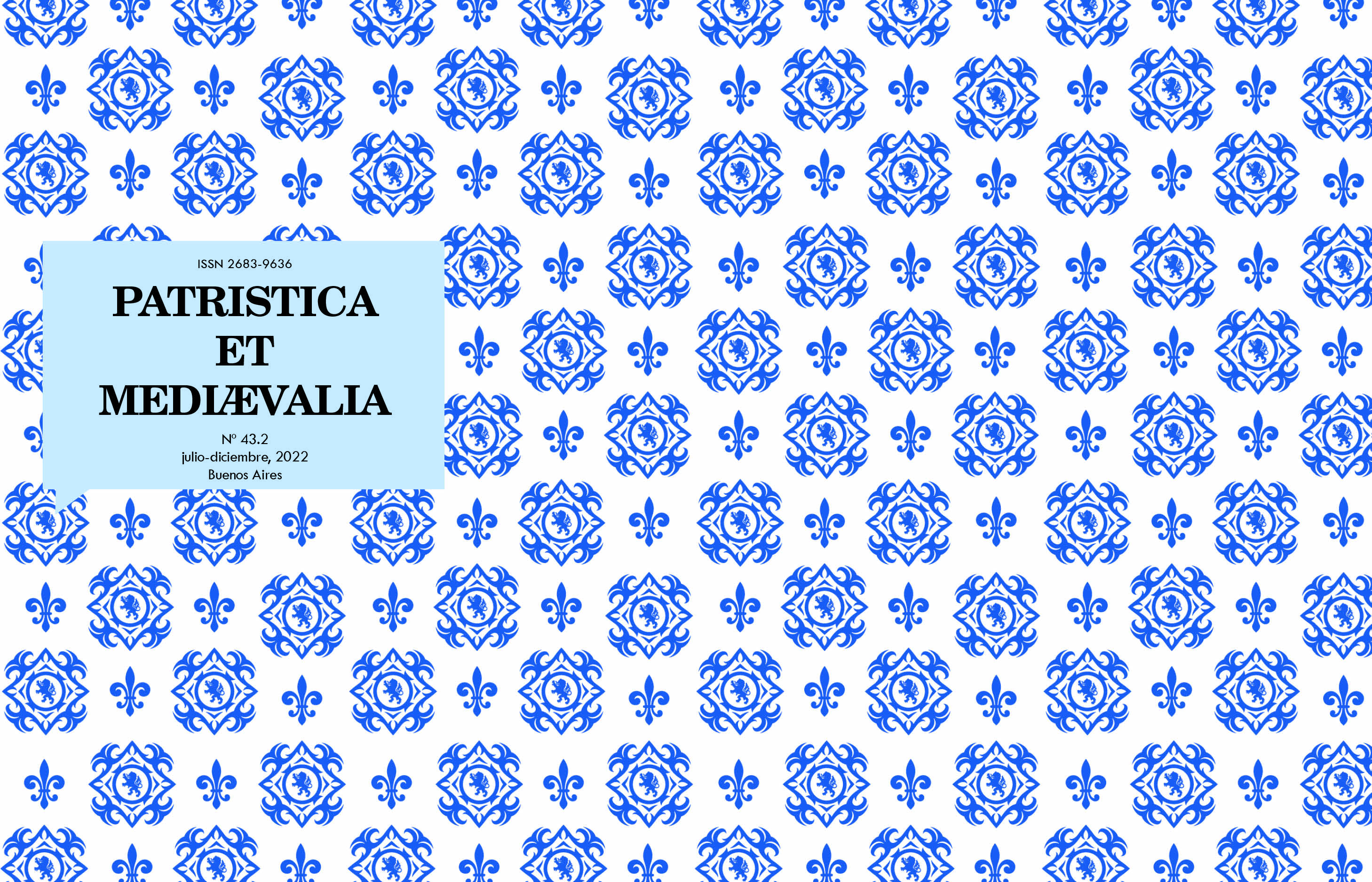Una lectura estética de la aequalitas en el De musica de Agustín de Hipona
Resumen
El concepto de igualdad articula el análisis de Agustín de Hipona en su diálogo De musica. Agustín comienza por el estudio técnico del ritmo de los versos latinos con la función de organizar los pies métricos de acuerdo con su cercanía a la igualdad. La cercanía a la igualdad es el criterio de la delectación, entendida como respuesta de los sentidos ante las proporciones simples. El análisis racional de la experiencia estética da lugar al ascenso del alma hacia Dios, identificado como fundamento de la belleza y de la delectación por las cosas proporcionadas y bellas. Este pasaje de la teoría musical a la filosofía de la música con alcances teológicos articula una teoría estética que aborda la experiencia estética y la reflexión sobre esta experiencia. Sostendremos que los tres momentos del diálogo permiten comprender el concepto de aequalitas de acuerdo con tres perspectivas: aritmética, estética y teológica. La igualdad aritmética es la relación entre dos cantidades iguales. La igualdad estética refiere a las relaciones entre las cantidades de la realidad temporal en tanto que son percibidas y respecto de su belleza. Por último, la igualdad teológica es una igualdad suprema, divina y ajena a la multiplicidad.Descargas
Citas
Agustín de Hipona (2007). Sobre la música. Trad. Luque Moreno, J. y López Eisman, A. Madrid: Gredos.
Augustinus Hipponensis (1892). De natura boni. Ed. Zycha, J. Leipzig: G. Freytag. (CSEL 25/2).
Augustinus Hipponensis (1962). De doctrina christiana. De vera religione. Ed. Daur, K. D. y Martin, J. Turnhout: Brepols. (CCSL 32).
Augustinus Hipponensis (1970). De ordine. Ed. Green, W. M. y Daur, K. D., Turnhout: Brepols. (CCSL 29).
Augustinus Hipponensis (1984). Retractationum libri II. Ed. Mutzenbecher, A. Turnhout: Brepols. (CCSL 57).
Augustinus Hipponensis (1986). De quantitate animae. Ed. Hörmann, W. Leipzig: G. Freytag. (CSEL 89).
Augustinus Hipponensis (2009). Epistulae CI-CXXXIX. Ed. Daur, K. D. Turnhout: Brepols. (CCSL 31B).
Augustinus Hipponensis (2017). De musica, Ed. Jacobssen, M. Berlín: De Gruyter. (CSEL 102).
Baumgarten, A. G. (1900). Meditationes philosophicae de nonnullis ad poema pertinentibus. Ed. Croce, B. Vecchi.
Bai, J. (2017). “Numbers: Harmonic Ratios and Beauty in Augustinian Musical Cosmology”, Cosmos and History: The Journal of Natural and Social Philosophy 13.3, 192-217.
Belgrano, M. (2016). “Itinerario del alma hacia Dios por medio de la Belleza desde las Confesiones de San Agustín”, Sapientia 72.239, 165-179.
Casas Rastrepo, F. (2016). “¿Es el De Musica de San Agustín un tratado sobre el arte musical?”, Franciscanum 58.166, 117-145.
Charru, P. (2009). “Temps et musique dans le pensée d’Augustin”, Revue d’Études Augustiniennes et Patristiques 55.2, 171-188. DOI: 10.1484/J.REA.5.101044.
Correa Pabón, G. L. (2009). Numerus-proportio en el De musica de San Agustín (Libros I y VI). La tradición pitagórico-platónica. Salamanca: Universidad de Salamanca.
De Bruyne, E. (1963). Historia de la Estética II. La Antigüedad cristiana. La Edad Media. Madrid: BAC.
Ellsmere, P. (1988). “Augustine on Beauty, Art and God”. En: La Croix, R. (ed.). Augustine on Music. An Interdisciplinary Collection of Essays. Nueva York: The Edwin Mellen Press, 97-113.
Forman, R. (1988). “Augustine’s Music: ‘Keys’ to the Logos”. En: La Croix, R. (ed.). Augustine on Music. An Interdisciplinary Collection of Essays. Nueva York: The Edwin Mellen Press, 17-28.
Hadot, I. (1984). Arts libéraux et philosophie dans la pensée antique. París: Études Augustiniennes.
Hoenig, C. (2018). Plato’s Timaeus and the Latin Tradition. Cambridge: Cambridge University Press.
O’Daly, G. (1987). Augustine’s Philosophy of Mind. Berkeley: University of California Press.
Polmann, K y Vessey, M. (2005). Augustine and the Disciplines. From Cassiciacum to Confessions. Nueva York: Oxford University Press.
Rey Altuna, L. (1986). “Fundamentación ontológica de la belleza”, Anuario filosófico 19.1, 105-134.
Shanzer, D. R. (2005). “Augustine’s disciplines: Silent diutius Musae Varronis?”. En: Polmann, K. y Vessey, M. (eds.). Augustine and the Disciplines. From Cassiciacum to Confessions. Nueva York: Oxford University Press, 69-112.
Tashchian, A. (2014). “Numerus as the Metaphysical Principle in St. Augustine’s Doctrine of Rhythm”, Laval Théologique et Philosophique 70.2, 331-342.
Tatarkiewicz, W. (2007). Historia de la estética. II. La estética medieval. Madrid: Akal.
Wiskus, J. (2016). “Rythm and Transformation Through Memory: On Augustine’s Confessions after De musica”, The Journal of Speculative Philosophy 30.3, 328-338. DOI: 10.5325/jspecphil.30.3.0328.
1. Los/as autores/as que publiquen en esta revista aceptan las siguientes condiciones:
-
Conservan los derechos de autor/a y ceden a la revista el derecho de la primera publicación, con el trabajo registrado con Licencia Atribución-CompartirIgual 4.0 Internacional, que permite a terceros utilizar lo publicado siempre que mencionen la autoría del trabajo y a la primera publicación en esta revista.
-
Pueden realizar otros acuerdos contractuales independientes y adicionales para la distribución no exclusiva de la versión del artículo publicado en esta revista (p. ej., incluirlo en un repositorio institucional o publicarlo en un libro) siempre que indiquen claramente que el trabajo se publicó por primera vez en esta revista.
-
Tienen permitido y se les recomienda publicar su trabajo en Internet (por ejemplo en páginas institucionales o personales).
2. Condiciones de auto-archivo. Se permite y se anima a los/as autores/as a difundir electrónicas la versión post-print de sus obras ya que favorece su circulación y difusión y con ello un posible aumento en su citación y alcance entre la comunidad académica. Color RoMEO: azul.













